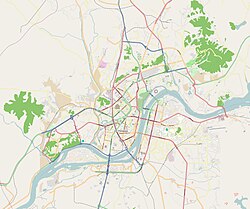| Location | Central District, Pyongyang, North Korea |
|---|---|
| Coordinates | 39°0′30″N 125°44′38″E / 39.00833°N 125.74389°E |
| Type | Culture venue |
| Capacity | 120 (cinema), 600 (Yun Isang Music Hall) |
| Opened | 2 April 1988 |
| Pyongyang International House of Culture | |
| Chosŏn'gŭl | |
|---|---|
| Hancha | |
| Revised Romanization | Pyeongyang Gukje Munhwa Hoegwan |
| McCune–Reischauer | P'yŏngyang Kukche Munhwa Hoegwan |
| External image | |
|---|---|
Pyongyang International House of Culture, also known as the Pyongyang International Cultural Center, is a cultural venue in the Central District of Pyongyang, the capital of North Korea. [2] It was opened on 2 April 1988. [3] It serves as venue for cultural exchange with foreigners. [1]
Venue
Architecturally it combines Korean elements with Soviet architecture. [4] It has a glass facade. [5] The venue has ten floors and the floor space spans 10,000 square metres (110,000 sq ft). [1]
Rooms dedicated to different cultural activities include art exhibitions, music practice and dance rooms, including a musical instrument room with 160 national instruments from all over the world. The building houses a cinema with the capacity of 120 seats [1] and simultaneous interpreting capabilities. [5] There is also a banquet hall, lounge, tea shop, and offices. [5] The venue also houses the Songhwa Art Studio, [6] and the Organizing Committee of the April Spring Friendship Art Festival. [7]
It houses the Yun Isang Music Institute. [8] The Yun Isang Music Hall, home of the Isang Yun Orchestra, is adjoined to the Pyongyang International House of Culture and houses further cultural facilities. [1] It has a capacity of 600 seats. [5]
The ground floor houses a permanent folkcraft exhibition with tradition Korean crafts [9] by the Korea Minye General Corporation. [10] Over 3,000 kinds of crafts, including Koryo celadon, are on display. [2] Koryo Cultural Tourist Company is also based in the building. [11]
See also
References
- ^ a b c d e Corfield, Justin (15 July 2013). Historical Dictionary of Pyongyang. Anthem Press. p. 177. ISBN 978-0-85728-234-7.
- ^ a b Choe Kwang Hyok (2013). "Inheriting Folk Tradition". Pictorial KOREA (11): 26. ISSN 1727-9208.
- ^ Pyongyang Review. Foreign Languages Publishing House. 1988. p. 96.
- ^ Willoughby 2014, p. 115.
- ^ a b c d "Pyongyang International House of Culture". Naenara. 19 October 2015. Retrieved 21 October 2015.
- ^ Willoughby 2014, p. 75.
- ^ "April Spring Friendship Art Festival". Uriminzokkiri. Archived from the original on 14 July 2023. Retrieved 19 February 2019.
- ^ "Past news". Korean Central News Agency. 1 July 1999. Archived from the original on 12 October 2014. Retrieved 21 October 2015.
- ^ "Folkcraft exhibition". KCNA. 28 December 2001. Archived from the original on 12 October 2014. Retrieved 21 October 2015.
- ^ "Folkcraft Showroom in Pyongyang International House of Culture". Naenara. Korea Pictorial. 2007. p. 2. Retrieved 21 October 2015.
- ^ Maierbrugger, Arno (March 2014). Nordkorea: Geschichte, Kultur, Sehenswürdigkeiten. Trescher Verlag. p. 194. ISBN 978-3-89794-257-8.
Works cited
- Willoughby, Robert (22 July 2014). North Korea. Bradt Travel Guides. ISBN 978-1-84162-476-1.
